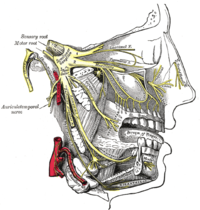
Photo from wikipedia
Pediatric trigeminal neuralgia has been rarely reported in the literature, which were only 28 cases. Although microvascular decompression (MVD) has been widely accepted as effective therapy for trigeminal neuralgia, the… Click to show full abstract
Pediatric trigeminal neuralgia has been rarely reported in the literature, which were only 28 cases. Although microvascular decompression (MVD) has been widely accepted as effective therapy for trigeminal neuralgia, the etiology and surgical treatment of pediatric ones are seldom addressed. We report our experience with MVD for pediatric trigeminal neuralgia patients with emphasis on the vascular conflict patterns and surgical skills. This retrospective report included 11 pediatric TN patients, who underwent MVD and were followed for 3–86 months. The data were retrospectively analyzed with emphasis on the clinical features. This series included 4 boys and 7 girls with average age of 13 ± 3.4 years old, their onset age were from 7 to 18 years old. The singular vein and combined artery/vein conflictions account for 7/11. 9 (81.8%) patients achieved immediate excellent outcomes. One recurrence was observed after 5 months and refused the second surgery. The etiology of pediatric onset trigeminal neuralgia is still vascular conflict, whose patterns are different from adults, of which combined artery/vein and singular venous compression patterns have a much more higher proportion. Because of the smaller operative space and fragile-thin venous wall with adhesion to other structures, it is much more difficult to decompress the trigeminal nerve among pediatric patients. Sufficient arachnoid release, full exploration, and decompression along the trigeminal nerve were necessary, which will increase the excellent rate among pediatric patients.
Journal Title: Child's Nervous System
Year Published: 2022
Link to full text (if available)
Share on Social Media: Sign Up to like & get
recommendations!